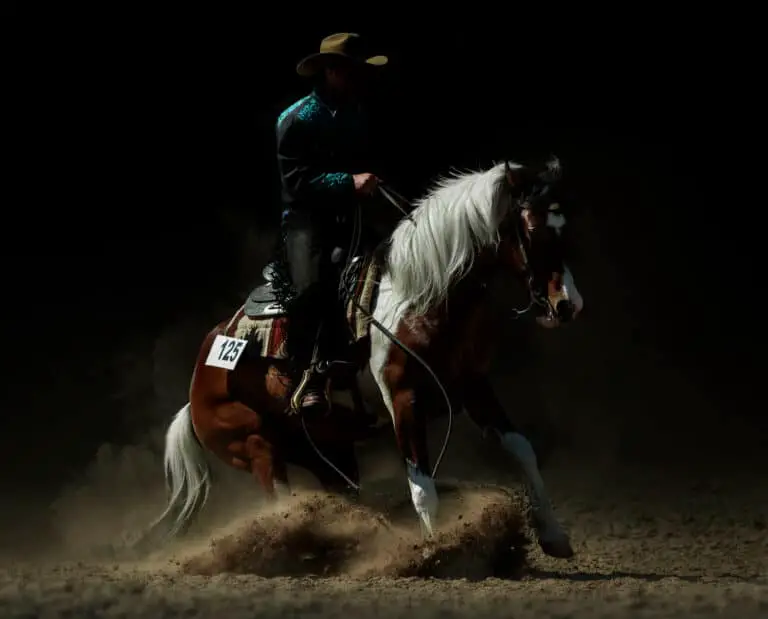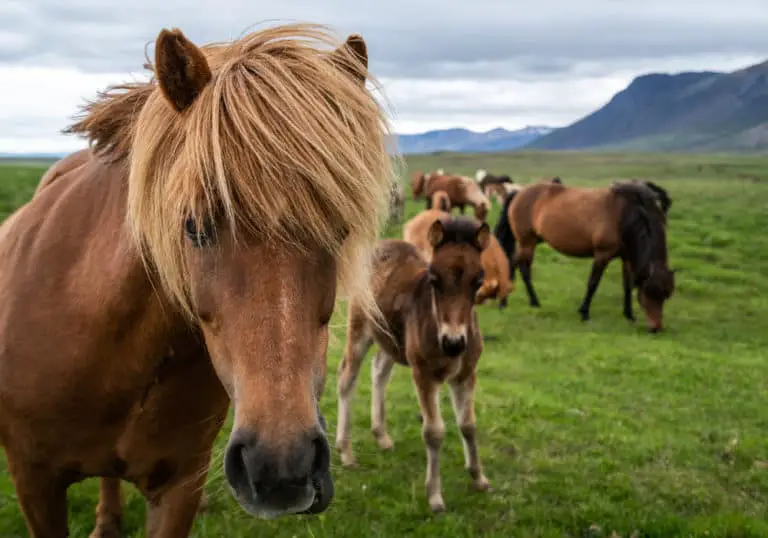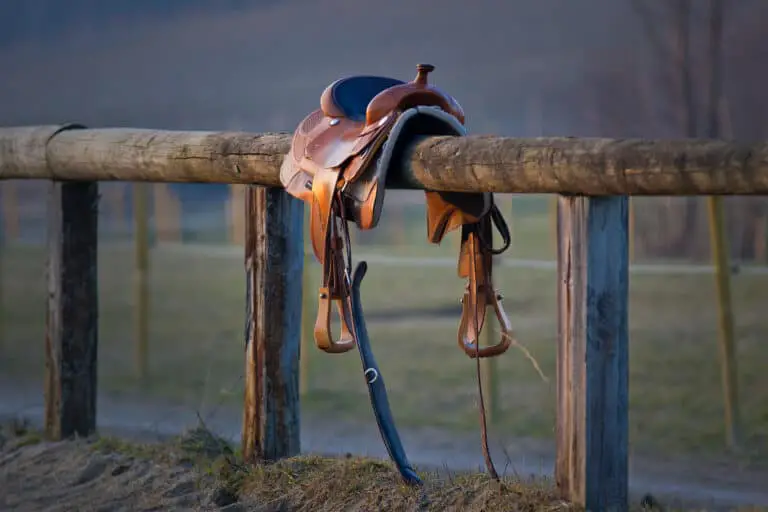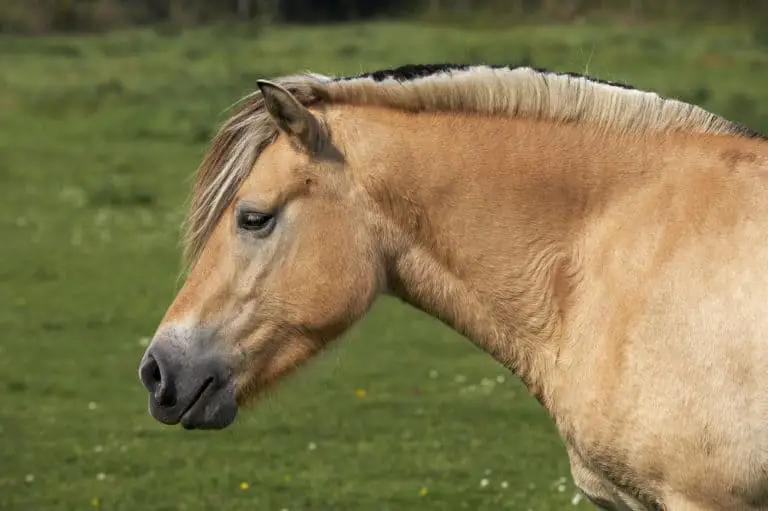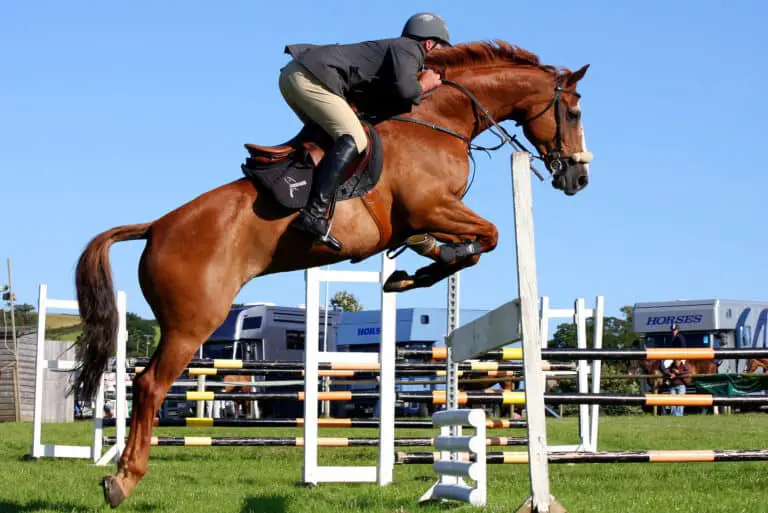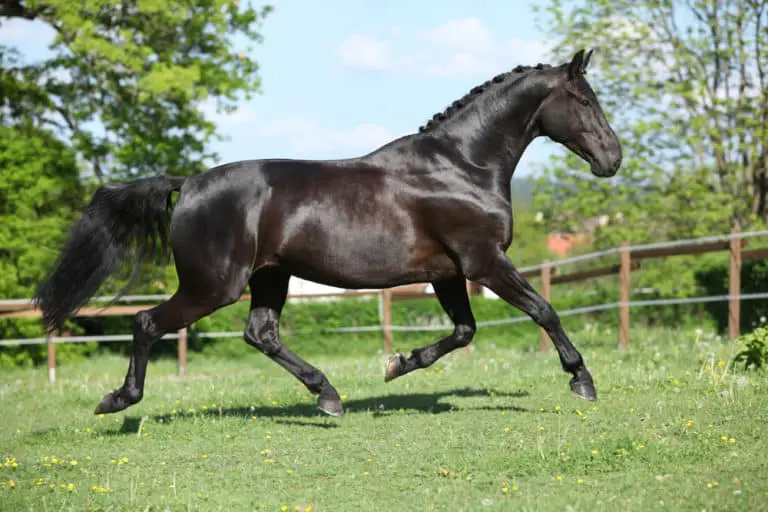Standardbred Horse Breed: Care, Cost & History (2025)
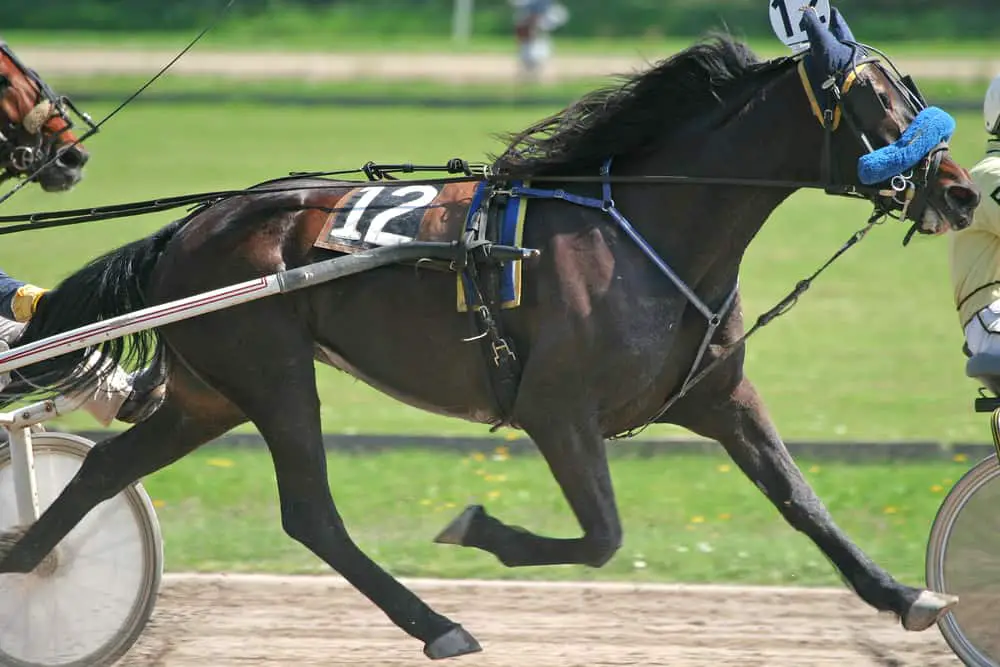
The fastest harness racing horse in the world is the Standardbred horse. The breed developed in the United States, where they still race, in addition to uses from trail riding to dressage. They race at a trot or a pace, a lateral gait. They earned their name because horses needed to meet a speed standard for registration.
Breed: Standardbred horse
Adult Weight: 800-1,000 pounds
Adult Height: 15-16 hands (60-64 inches)
Origin: United States
Use: Racing, pleasure riding, driving, trail
Colors: Bay, brown and black are the most common
Features: Refined head, long body, and legs
Lifespan: 25 years
Character: Calm, friendly, and steady
Gait: Smooth and fast with a long stride, some trot and others pace
Best for: Intermediate and Advanced Riders
- Characteristics
- Standardbred Care
- Standardbred History
- Modern Standardbreds
- Cost and Ownership
- Buying a Standardbred
- Similar Breeds
Standardbred Horse Characteristics
Standardbred horse characteristics are similar but distinct from the Thoroughbred, one of their ancestors. The Standardbred horse head is refined with large eyes, and placed on an upright neck. They have a long body and long legs, which help gives them their speed. The hind legs are set well back on the sleek and muscular hindquarters.
Size
Standardbred horse height ranges from 15 to 16 hands, with most people acknowledging 15.2 hands as the average. (1) There are some members of the breed that are slightly taller or shorter but this range is generally accepted and seen in most horses.
Males are slightly taller than females. Non-adult horses, or foals, are 73% of their adult height at three months of age. Standardbreds are known for their long legs, and the foal’s legs will reach their full height at one year of age. (2)
Standardbred size is slightly shorter than their Thoroughbred racehorse counterparts, but ideal for people that want to use the horses for pleasure riding.
Weight
Standardbred horses are a slightly stocky breed, given their height. The Standardbred horse weight is between 800 and 1,000 pounds on average. Male horses tend to be larger than female horses.
A Standardbred foal weighs about 10% of its dam’s weight at birth, therefore, a mare that weighs 950 pounds should have a 95-pound foal. Non-adult horses reach 43% of their adult weight when they are six months old and are full-grown at six years old, although some are done developing sooner.
They have a well-defined and solid bone structure that can withstand the pressure and concussion that racing speed produces while supporting the muscular body.
Colors
Standardbred horse colors are bay, brown, black, chestnut, and grey, with bay, brown and black being the most common. There are some rare Standardbred horse colors, including roan, pinto, and white. While these aren’t seen as often, horses that are these colors can be registered.
The beautiful Standardbred horse can have white markings on its face and legs, although these are usually minimal and aren’t as common. Most horses are solid-colored horses.
Bay, brown, and black became the most popular colors because horses are bred for speed and the phenotype for the bay is dominant. Therefore, as more horses of these colors were bred, their color phenotypes were also passed on.
Temperament
Standardbred horse temperament is known as calm, steady, and friendly. They enjoy being with people and the consensus among horse trainers is that the horses are easy to train.
This easygoing personality doesn’t mean they aren’t competitive – the horses love to race! But, their Standardbred horse behavior makes them incredibly well-behaved and respectful while they are on the track or being used in another discipline.
Many consider Standardbreds as beginner safe horses, and they are because of their temperament. But their gaits can be hard to learn to ride on.
The Standardbred horse breed uses the United States Equestrian Federation general rules at competitions, so children aren’t allowed to exhibit stallions. (3)
Standardbred Horse Care
The kind and easygoing temperament of the Standardbred horse makes them easy to care for as well. They require basic care and shelter that all horses need, but there isn’t a lot of additional fuss needed. The average Standardbred horse lifespan is 25 years and they are usually sound and healthy throughout their life.
Diet and Nutrition
The Standardbred diet is important to their health and wellbeing. Horses need six major nutrients: water, protein, carbohydrates, fats, vitamins, and minerals. These are needed to give the horse energy, help them regulate its body temperature, and other crucial functions. (4)
Horses receive these nutrients from fiber sources like pasture and hay, concentrates like grain, and dietary supplements. (4) An equine nutritionist or veterinarian can help you balance your horse’s diet and make sure they are meeting nutritional requirements.
American Standardbreds eat about the same amount as other regular-sized horses. Age, climate, and the amount of work a horse is doing influence how much they eat.
Health Problems
In general, Standardbred horses are a healthy breed with few problems. There are some genetic problems and diseases seen more in racehorses because of the exertion required.
Racehorses tend to be more susceptible to respiratory diseases. The Standardbred can have upper and lower airway abnormalities. Exercise-induced pulmonary hemorrhage is one lower airway issue they face, and it can be prevented by careful management of Standardbred horse training and veterinary checkups. (5)
Musculoskeletal issues are also a problem for the harness horse, again, given the exertion the horse’s body withstands during training and racing. Injured horses usually recover after rest, and careful training regimens can help prevent injuries. (6)
Grooming
Grooming a horse is important to their overall health, helps them bond with people, and also provides some enrichment activity in their day.
Standardbred grooming is similar to that of other breeds. Of course, safety comes first, and a person should know how to handle a horse before grooming them. The Standardbred’s kind temperament makes this a little easier too.
The tools needed for grooming include a curry comb, mane and tail brush, dandy or stiff brush, a finishing brush or towel, and a hoof pick. Ideally, horses should be groomed every day. They also need their feet picked daily to prevent any health problems. (7)
Standardbred Horse History
Horse racing gained popularity in the 1700s and this continued into the 1800s, as people bred faster horses that could win races. The Morgan horse was the fastest trotting horse in the United States, but then a horse named Hambletonian 10 was born in 1849 and Standardbred horse history began.
Origin
Obviously, the breed didn’t just begin the day that Hambletonian 10 was born. Standardbred horse origin goes back to Thoroughbred breed development in England. Once people started carefully breeding this distinct type, a horse that could meet a standard time trotting or pacing a mile, the breed further developed, thanks to the strong bloodlines of Hambletonian 10.
The first official registry was formed in 1879 in the United States. Other ancestors of the breed, including the Thoroughbred, were the Norfolk Trotter, the Morgan, the Narragansett Pacer, the Canadian Pacer, and the Hackney.
As there were more and more Standardbreds, the bloodlines of these other breeds disappeared until they became a pure bloodline registry.
Historic Development
Standardbreds originally had to meet the “standard” of being able to trot a mile in less than two minutes and 30 seconds. Horses today (and since that standard was established in 1879) are faster.
The breed has two distinct types of racehorses too, the trotters and the pacers. A trotter horse races using the same two-beat diagonal trot of other horses. The pace is a two-beat lateral gait, meaning the two legs on the left side move together and the two legs on the right side move together.
The pacers are slightly faster than the trotters. The horses all trace their bloodlines back to Hambletonian 10, but there are different bloodlines and families popular among the trotters and the pacers.
Notable Standardbred Horses
History and modern times are filled with famous Standardbred horses. Of course, there is Hambletonian, whose Standardbred horse pedigree is the foundation for all others. There are also the pacers Dan Patch and Niatross who have captured records and made themselves into household names during different parts of the 20th century.
Hambletonian 10
The birth of Hambletonian 10 in 1849 set the stage for the Standardbred breed. He is the foundation sire and had a sensational racing record before becoming a stallion. Hambletonian is a great-grandson of Messenger, a famous Thoroughbred racehorse. Hambletonian sired over 1,331 foals and over 90% of modern Standardbreds chase their bloodlines to him.
Dan Patch
Dan Patch was a Standardbred stallion and pacer with celebrity status. He lived from 1896 to 1916, in racing’s heyday, and traveled to races in a private train car. Dan Patch was so fast that people stopped entering their horses against him – his speed record at the mile in harness stood for 30 years.
Niatross
Many believe that Niatross is the greatest Standardbred racehorse of all time. He was born in 1977 and won over $2 million in prize money throughout his career. Niatross was a pacer, and honors include breaking the speed barrier for 1:52, 1:51, and 1:50, and winning the harness racing triple crown.
Myths and Legends
The equestrian world is filled with myths and legends, and the Standardbred horse legends abound because of their abilities on the racetrack. Although these legends are from the earlier days of the breed, horses continue creating new legends with their speed, versatility, and personalities. Many legends also involve finding a diamond in the rough that becomes a famous racehorse.
Contributions of the Canadian Pacer
Legend has it that the Canadian Pacer is responsible for more of the American Standardbred horse development than they receive credit for. In fact, the Canadian Pacer figured heavily into the development of the Standardbred and the Morgan, and early photos of the two breeds look eerily familiar, and a lot like those of the Canadian Pacer.
From Farm Hand to Racehorse Owner
Hambletonian’s owner, William Rysdyk, worked on the farm where the colt was born. Rysdyk bought the mare and colt for $125. He knew he had something special and started racing his colt and standing him at stud at a young age. Hambletonian earned over $200,000 in stud fees for his owner during the horse’s lifetime.
The Crooked Leg of Dan Patch
Dan Patch was actually born with a crooked leg and couldn’t stand up; his breeder helped him. They designed a special sulky for him when they first started racing so he wouldn’t bang his leg into the wheel. They eventually developed a special shoe to solve this problem. This is just one of many legends of the famous horse.
Modern Standardbred Horses
There are still two types of Standardbred horses – the trotters and pacers. Although most people think of the breed as primarily for Standardbred horse racing, they have many other uses as well, and horses are bred for other purposes too. Horses who are unsuccessful or uninterested on the track move into second careers where they excel.
Breeding
Standardbred breeding is predominantly in the United States because that is where the breed was formed. However, there are also breed associations in Canada and Great Britain, and some individual horses can be found in other locations too.
Pacers tend to be more popular as racehorses and you’ll see more races for these horses because of their popularity. Horses that pace can also trot – it’s just that they are trained not to trot when in harness or in a race.
Standardbred horses breeding is specific to trotters or pacers though. If you’re looking at a Standardbred for something other than racing, it’s best to talk to someone who knows and understands bloodlines.
Population
The Standardbred horse population in the United States includes more than 700,000 horses. (8) There are smaller populations in Canada and Great Britain, with more in Canada because of its proximity to the United States.
Harness racing’s continued popularity means the breed is not endangered, and recent promotion of the versatility of the Standardbred is actually increasing their popularity among equestrians.
The U.S. Trotting Association is based in Ohio and many Standardbreds are found in the central part of the United States. However, horses can also be found in other locations throughout the country. There are also unregistered and crossbred horses that increase the total population.
Uses
Standardbred horse uses are varied because the breed is homozygous for three important genes – speed, stamina, and gait – and this is an advantage they have over all other breeds. This makes the Standardbred a great racehorse, and also talented in many other disciplines, including dressage, endurance, and jumping, among others.
In fact, there are more Standardbreds jumping because of these traits. Merlin, a Standardbred gelding, is one example. He jumps cross-country in a hackamore with his owner and is an ambassador for the breed.
The Standardbred horse gait can be bouncy for newer riders; they have a powerful trot that a rider needs to get used to. But, once they do, people become devoted to the breed.
Standardbred Horse Prices
Owning a horse can be the fulfillment of a lifelong dream, but every dream comes with a price. The Standardbred horse price is high because the care and upkeep of a horse are expensive, but many people are unfamiliar with the actual costs involved. Understanding these prices before you purchase a horse can help make the dream a reality.
Purchase Price
The purchase price of Standardbred horse varies depending on the age, bloodlines, and potential use of the horse. Racehorses cost the most and horses purchased for pleasure riding or driving will cost less – between $500 and $5,000.
Standardbred yearlings at a sale cost around $20,000. Stud fees for mares bred to a Standardbred stallion cost between $1,000 and $10,000, depending on the bloodlines and performance history of the stallion. (9)
There are exceptions to this. A yearling named Maverick is said to have sold for $1.1 million at a sale in 2019, it was thought that he would be an excellent racehorse.
Ownership Costs
Okay, so you found the perfect Standardbred and the purchase price is within your budget. The Standardbred horse cost of ownership comes next. This is non-negotiable because it’s the basic care and upkeep for the horse’s survival – shelter, feed, and health care. Expect the Standardbred price to be $1,770 to $12,930 annually.
Board
Think about your home for a minute, it keeps you safe and gives you a place to rest. Horses need a home too, and this is what their board covers. It’s their stall and pasture, or a run-in shed in a field. The Standardbred horse board cost is between $1,200 and $7,200 every year. (10)
Feed
Feed costs are those that meet the diet and nutrition requirements of the horse. They will vary depending on your location, the amount of grass the horse has access to, and how much the horse is working. The range is between $250 and $4,380 for Standardbred horse feed cost, depending on all these variables. (10)
Veterinary Care
A veterinarian is an important person in the horse’s life. All horses need basic care, annual vaccines, deworming, and dental care. The Standardbred horse veterinary cost is between $250 to $350 each year for basic care. Accidents or illnesses can add additional costs up to $1,000 to this price. (10)
Hoof Care
Horses need to have their hooves trimmed six or seven times each year to maintain their hoof health and soundness. The hooves grow non-stop, and trimming them regularly is essential. The Standardbred horse hoof care cost is $120 to $1,000 each year, spread out across each of the individual visits. (10)
Buying a Standardbred Horse
Buying a Standardbred is exciting, but it’s overwhelming if you don’t do your homework first. Include some research on horse bloodlines in the horse buying process and which are best for the discipline that you want to ride or drive the horse in. The Standardbred breed is versatile and kind, but it’s still important to find the right horse.
Is the Standardbred Horse Right for You?
Owning a Standardbred is right for you if you want a hardy and sure-footed horse with relatively few health issues and plenty of stamina. These horses can go and will keep going until you ask them to stop because of their genetics and willingness to please people.
Riding a Standardbred horse isn’t the first thing people think about with this breed, but perhaps it should be. They easily pop over a course of jumps or move down the trail with their ground-covering stride. They are athletic and talented in dressage and are a wonderful pleasure driving horses too. Adults and children alike can enjoy the Standardbred.
How to Buy a Standardbred Horse?
The best thing to do when buying a Standardbred horse is to find a Standardbred breeder that can help you. First, explain what your goals are for owning a horse, whether that’s a pleasure riding and keeping them in your backyard, showing, or competing in endurance competitions.
Next, ask about Standardbred bloodlines and which horses are suited for the discipline you want to pursue. Then, ask the breeder who has horses available that you can go and try out.
Go and meet several horses and try them out. Even though Standardbreds are people-oriented, they all have unique personalities, just like we do, and you’ll get along with some horses better than others.
Similar Breeds to Standardbred
There are several Standardbred breed alternatives, including the Thoroughbred, Morgan, and Quarter Horse. All three breeds have similar ancestry and are known for their athleticism. The Thoroughbred and Quarter Horse are racehorses too, while the Morgan is a popular riding and driving horse, with a similar body type to the Standardbred. All three breeds are popular in the United States.
Thoroughbred
Thoroughbreds developed in England and are known for their speed and athleticism as racehorses. Unlike the Standardbred, the Thoroughbred is ridden in races and sometimes also jumps during races, a sport called steeplechasing. Both breeds are athletic and fast; with successful careers beyond racing. The founding sire of the Standardbred breed was a Thoroughbred.
Morgan
Morgan horses are another American breed of horses that were known for speed in trotting races. The Standardbred eclipsed the Morgan as the harness racing horse, but a Morgan is an excellent alternative for those seeking pleasure riding and driving a horse. Morgans are slightly smaller than Standardbreds with inquisitive and endearing personalities.
Quarter Horse
The Quarter Horse earned its name because of its speed covering the distance of a quarter-mile. Quarter Horses still race today and are also the most popular horses in the United States, used for pleasure riding in English, western, and trail disciplines. They are stockier than the Standardbred and also have a calm and kind temperament.
FAQ
What is a Standardbred horse?
A Standardbred horse is an average-sized animal with long legs, a kind disposition, and incredible speed at the trot and pace – a lateral gait.
What’s the difference between standardbred vs. thoroughbred?
Standardbreds are shorter and slightly stockier with a calmer temperament than Thoroughbreds, making them better suited to harness racing.
What’s the difference between standardbred vs quarter horse?
Standardbreds have a leaner and more athletic body shape, with an upright head and neck than Quarter Horses, whose power comes from their strong hindquarters.
What does a Standardbred horse look like?
A Standardbred horse is usually bay, brown, or black with a refined head and a long body and legs.
How did the Standardbred horse get its name?
The Standardbred horse name comes from the original breed registry requirement that horses trot or pace a mile in a certain amount of time.
Can you ride a Standardbred horse?
Yes, you can ride a Standardbred horse, and they are used for dressage, trail riding, endurance, driving, and other disciplines.
Are Standardbred horses good for beginners?
Unfortunately, Standardbred horses aren’t good for beginners. Their gaits are rough to ride for those new to horses; it’s better to learn on another breed.
How tall is a Standardbred horse?
Standardbred horses are between 15 and 16 hands tall at the withers or 60 to 64 inches. The most common height is 15.2 hands.
How much does a Standardbred horse weigh?
A Standardbred horse weighs between 800 and 1,000 pounds.
How big is a Standardbred horse?
A Standardbred horse is an average-sized horse, although its athletic appearance and long legs make them appear bigger.
How much does a Standardbred horse cost?
A Standardbred yearling can cost $20,000 and stud fees are between $1,000 and $10,000. Non-racing horses generally cost less.
How much does a Standardbred horse ownership cost?
Standardbred horse ownership costs between $1,770 to $12,930 each year.
How long do Standardbred horses live?
The average Standardbred horse lives for 25 years.
How fast can a Standardbred horse run?
A Standardbred horse can run between 30 and 35 miles per hour. The fastest horses can go 40 miles per hour.
How much can a Standardbred horse pull?
A Standardbred horse can pull between 1,200 and 1,500 pounds.
How much can a Standardbred horse carry?
A Standardbred horse can carry between 160 and 200 pounds.
At what age is a Standardbred horse full grown?
A Standardbred horse is full-grown at six years old.
What are Standardbred horses used for?
Standardbred horses are used for racing as both trotters and pacers. Those not racing are used for trail riding, dressage, driving, and other pursuits.
References
- The United States Trotting Association. 2022. Foal Registration. Link
- National Cooperative Extension Resource. 2019. How Can I Measure My Colt Now To Determine His Full Height When Fully Grown? Link
- United States Equestrian Federation. 2022. Licensed Competitions. Link
- National Cooperative Extension Resource. 2020. Nutrients and Common Feed Sources for Horses. Link
- Anne Couroucé-Malblanc, Kenneth W.Hinchcliff. 2014. Veterinary Aspects Of Racing And Training Horses Used For Harness Racing (Trotters And Pacers). Link
- Andrea Bertuglia, Michela Bullone, Federica Rossotto, Mauro Gasparini. 2014. Epidemiology Of Musculoskeletal Injuries In A Population Of Harness Standardbred Racehorses In Training. Link
- National Cooperative Extension Resource. 2019. How to Groom a Horse. Link
- The United States Trotting Association. 2022. What is the USTA and why join? Link
- Performance Standardbreds. 2022. Myths About Standardbreds. Link
- Arabian Horse Association. 2022. What is the Cost of Providing for Them? Link

